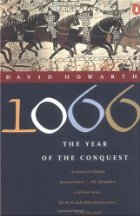 1066: The Year of the Conquest by David Howarth
1066: The Year of the Conquest by David Howarth
Paperback: 208 pages
Publisher: Penguin (Non-Classics) (August 27, 1981)
Language: English
ISBN-10: 0140058508
The year 1066 is one of the most pivotal years in the history of England. At the beginning of the year, the land was at peace, and by the end, everything had changed. In the book 1066: The Year of the Conquest, David Howarth draws on a host of contemporary accounts to understand exactly what happened to turn England upside down. As with any contemporary sources of history, biases emerge that attempt to hold one side in high esteem above the other, so the author and the reader must wade through these evidences to come to their own conclusions of the truth.
The book opens in the tiny village of Horstede, England (called Little Horsted today). By car, Horstede is only about an hour from Hastings, and for the most part it was isolated from the battle that occurred on the 14th of October, 1066, but it would later feel the impact as the changes implemented by a new king swept across the English landscape. Horstede reflects the everyday life of a commoner in England at that time, and for these villagers, the beginning of 1066 was filled with uncertainty, but not with dread.
King Edward the Confessor had died, and the witena gemot came together to decide who would be the king’s successor. They chose Harold Godwinson, and it was this decision that sparked the events that would unfold throughout the remainder of the year.
Contemporary sources and later historians debate the succession of Edward the Confessor with great fervor. David Howarth examines both sides in an effort to find a resolution concerning the controversial election of Harold to the throne. He looks at the motives behind both Harold and Duke William of Normandy, the two main figures in contention for the English crown, while in the background lurks Harold’s brother, Tostig, and the King of Norway, Harald Hardrada.
Harold demonstrates his military genius when he force marches his army to cut off the invasion of Hardrada and Tostig in the north of England. The two armies meet at the Battle of Stamford Bridge, where Harold wins a defining victory.
But the hand of fate or luck or God does not remain with Harold for long. As soon as he defeats Hardrada, he learns Duke William has landed on the southern coast of England at Pevensey. He must turn his tired army around and march south to stop a second invasion.
William’s stroke of luck to land at England at just the right time is amazing. Harold had been waiting all summer for the invasion, which never came, and then Harold learned of the invasion in the north, and soon after he left, the winds blowing across the channel turned in William’s favor. Harold did not think William would invade because it was past the normal season for good sailing, and the year was moving well into Autumn. William was fortunate his fleet was not scattered at sea or dashed on the English coast or thrown ashore at a disadvantageous landing point, but the fleet survived the journey across the channel and arrived on the English coast at the end of September.
The following weeks in terms of Harold’s character are a bit perplexing to historians. Harold had won a great victory at Stamford Bridge, but when he learned of William’s arrival, his mood seemed to change. In the weeks leading up to the battle at Hastings, Harold almost seemed to accept defeat, if that was his fate. Howarth argues it was the support William obtained from the Pope that seemingly paralyzed Harold into inaction. The man who demonstrated great skill at Stamford Bridge was not the same man who stood with his army on the top of Senlac Hill, waiting for William’s army to come, waiting for his destiny, waiting for his verdict. In his mind, he was already a defeated man, because God had judged him and England.
The story ends where it began: with the little village of Horstede. The conquest changed villages like Horstede and the whole of England forever, though ultimately, it is the English who claim victory because they never lost their identity, and the Normans eventually assimilated to become English instead of the other way around. England remained forever English.
My rating: 5 stars
I have this one but haven’t gotten to it yet. Thanks for the review – it sounds like a good book!
It is very good! It is well-written and reads almost like a novel in parts.
I read the Howarth book a long time ago. I’ll obviously have to reread it. I don’t recall a lot of what was in it. But I recall it was a pretty good overview of the fateful year of 1066 for the English.
Anne G
The next book I’m planning to read is Harold: The Last Anglo-Saxon King by Ian Walker.